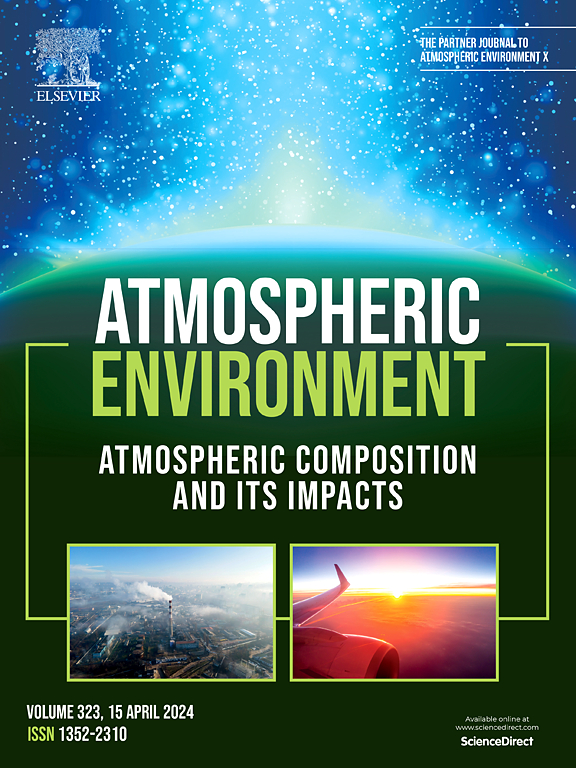Formaldehyde variation in urban Beijing: Levels, sources, budget, and ozone impact
IF 3.7
2区 环境科学与生态学
Q2 ENVIRONMENTAL SCIENCES
引用次数: 0
Abstract
As a key precursor of radicals and ozone (O3), formaldehyde (HCHO) affects the atmospheric oxidative capacity of the troposphere. Herein, we investigated seasonal variation of HCHO levels, sources, sinks, and its impact on O3 based on 17-month online measurements of HCHO and other trace gases at an urban site in Beijing. The average mixing ratio of HCHO during the warm season was 6.09 ± 3.37 ppbv, marking an increase of approximately 50 % compared to the cold season. During the warm season, HCHO accounted for 26.6 ± 6.9 % of the average mixing ratio and 34.6 ± 8.3 % of the OH reactivity for total volatile organic compounds (VOCs), approximately double the levels observed in 2011. The positive matrix factorization analysis reveals that photochemical production accounted for 71.4 % of the average HCHO level during the warm season, while vehicular exhaust contributed 50.6 % during the cold season. A budget analysis of HCHO production (PHCHO) and destruction (DHCHO) rates using a box model based on observations (OBM) shows that during the daytime in the warm season, PHCHO was close to DHCHO, suggesting a near closure of the HCHO budget. During the cold season, DHCHO surpassed PHCHO, possibly driven by primary emissions. The dominant HCHO production pathways were reactions of alkoxyl radicals with oxygen, while its major destruction processes were the reaction with OH radical and self-photolysis during both seasons. The relative incremental reactivity (RIR) values of nitrogen oxides determined using the OBM were negative during the summer. However, these values showed a significant increase from 2011 to 2022, indicating that while O3 production in urban Beijing was primarily VOC-limited, the influence of NO titration on O3 decreased over the decade. The RIR value of HCHO increased by 50 % from 2011 to 2022. Moreover, in 2022, HCHO has become the second most important VOC for O3 formation, following isoprene. This underscores its crucial role in shaping future O3 control measures.

北京市区甲醛变化:水平、来源、预算和臭氧影响
甲醛(HCHO)作为自由基和臭氧(O3)的关键前体,影响对流层的大气氧化能力。在此基础上,基于北京某城市站点17个月的HCHO和其他微量气体在线测量,研究了HCHO水平、源、汇的季节变化及其对O3的影响。暖季HCHO的平均混合比为6.09±3.37 ppbv,比冷季增加了约50%。在暖季,HCHO占总挥发性有机物(VOCs)平均混合比的26.6±6.9%,占OH反应活性的34.6±8.3%,约为2011年的两倍。正矩阵分解分析表明,暖季光化学产量占平均HCHO水平的71.4%,冷季汽车尾气占50.6%。利用基于观测(OBM)的箱形模型对HCHO产生(PHCHO)和破坏(DHCHO)速率进行预算分析,结果表明,暖季白天,PHCHO接近DHCHO,表明HCHO预算接近关闭。在寒冷季节,DHCHO超过PHCHO,可能是由一次排放驱动的。在两个季节中,HCHO的主要生成途径是烷氧基自由基与氧的反应,而其主要的破坏过程是与OH自由基的反应和自光解。利用OBM测定的氮氧化物的相对增量反应性(RIR)值在夏季为负值。但从2011年到2022年,这些数值呈现出显著的增加趋势,表明虽然北京城市O3的产生主要是vocs限制的,但随着时间的推移,NO滴定对O3的影响有所减弱。从2011年到2022年,HCHO的RIR值增长了50%。此外,到2022年,HCHO已成为仅次于异戊二烯的O3形成的第二大VOC。这强调了其在制定未来O3控制措施方面的关键作用。
本文章由计算机程序翻译,如有差异,请以英文原文为准。
求助全文
约1分钟内获得全文
求助全文
来源期刊

Atmospheric Environment
环境科学-环境科学
CiteScore
9.40
自引率
8.00%
发文量
458
审稿时长
53 days
期刊介绍:
Atmospheric Environment has an open access mirror journal Atmospheric Environment: X, sharing the same aims and scope, editorial team, submission system and rigorous peer review.
Atmospheric Environment is the international journal for scientists in different disciplines related to atmospheric composition and its impacts. The journal publishes scientific articles with atmospheric relevance of emissions and depositions of gaseous and particulate compounds, chemical processes and physical effects in the atmosphere, as well as impacts of the changing atmospheric composition on human health, air quality, climate change, and ecosystems.
 求助内容:
求助内容: 应助结果提醒方式:
应助结果提醒方式:


